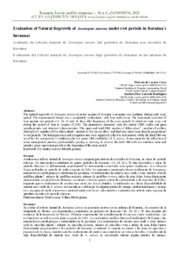Evaluation of Natural Regrowth of Axonopus aureus under rest periods in Roraima's Savannas.
Evaluation of Natural Regrowth of Axonopus aureus under rest periods in Roraima's Savannas.
Author(s): COSTA, N. de L.; RODRIGUES, A. N. A.
Summary: The natural regrowth of Axonopus aureus in native pasture of Roraima ́s savannas was evaluate, during early rainy period. The experimental design was a completely randomized, with four replications. The treatments consisted of four pasture rest periods (14, 28, 42 and 56 days after beginning of the rainy period). Evaluations were carry out during the period of June to August of 2016. The parameters measured were dry matter (DM) yields and grass morphogenetic and structural characteristics. The green and total DM, number of tillers plant-1, number of axillary tillers plant-1, number of live tillers plant-1, number of live leaves tiller-1 and leaf area index were directly proportional to rest periods. The leaf appearance and elongation rate were negatively affect by rest periods, while the dead DM was not affect by rest periods. Considering the low green DM availability of A. aureus, its recommends the utilization of some management practice, preferentially grazing or mowing, to remove the dead DM with low nutrition value and permit a grass vigorous regrowth in the beginning of the rainy period.
Publication year: 2021
Types of publication: Journal article
Unit: Embrapa Roraima
Keywords: Dry matter, Leaves, Morphogenesis
Observation
Some of Embrapa's publications are published as ePub files. To read them, use or download one of the following free software options to your computer or mobile device. Android: Google Play Books; IOS: iBooks; Windows and Linux: Calibre.
Access other publications
Access the Agricultural Research Database (BDPA) to consult Embrapa's full library collection and records.
Visit Embrapa Bookstore to purchase books and other publications sold by Embrapa.

